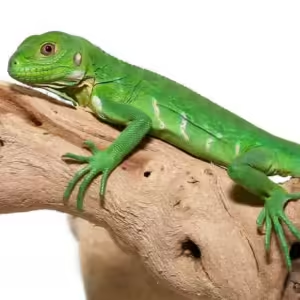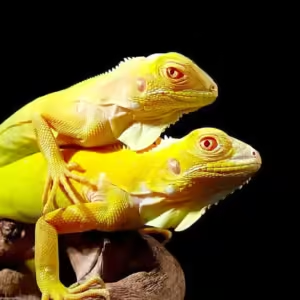Lesser Antillean Iguana For sale
$999.99
WE HAVE LESSER ANTILLEAN IGUANA FOR SALE. HERE ARE SOME HIGHLIGHTS:
- Iguana delicatissima
- Captive Bred
- Approximately 10 – 12 Inches From Head To Tail
- Adults Will Average In Sizes Around 5-6 Feet In Length
- This Is A Herbivore That Is Eating Dark Leafy Greens, Squash And Carrots, Etc.
FUN FACTS!
- These Develop Beautiful Markings As They Mature
- Originating From The Lesser Antilles Islands
- With Good Care And Handling These Iguanas Can Live Up To 15-20 Years
- This Is A Tropical Species Requiring Temperatures In The 80s – 90s And UVB Lighting
Lesser Antillean Iguana
The Lesser Antillean Iguana, scientifically known as Iguana delicatissima, is a fascinating species that captivates both researchers and nature enthusiasts alike. This remarkable reptile is indigenous to the Lesser Antilles, a chain of islands in the Caribbean Sea. What sets the Lesser Antillean Iguana apart from other iguana species is its distinctive physical and behavioral characteristics. Notably, this iguana exhibits a more delicate appearance compared to its relatives, with a smaller size and a unique coloration that varies from shades of green to bluish-grey hues. The species is also known for the absence of the prominent subtympanic plate seen in other iguanas, adding to its unique profile.
Studying the Lesser Antillean Iguana is essential for several reasons. Firstly, it serves as an indicator species, reflecting the health of its habitat. The iguana’s presence and population trends can provide valuable insights into the ecological state of the Lesser Antilles. Secondly, this species is currently classified as endangered, primarily due to habitat loss, predation by invasive species, and human encroachment. Understanding its biology, behavior, and ecological needs is crucial for developing effective conservation strategies.
Additionally, the Lesser Antillean Iguana plays a vital role in its ecosystem. As herbivores, these iguanas contribute to seed dispersal and vegetation management, promoting biodiversity within their habitat. Their interactions with other species and the environment are integral to maintaining ecological balance. By delving into the specifics of the Lesser Antillean Iguana, we not only enhance our scientific knowledge but also foster a greater appreciation for the intricate web of life in the Caribbean islands.
This comprehensive guide aims to shed light on the various aspects of the Lesser Antillean Iguana, from its physical traits and behavior to its ecological significance and conservation efforts. Through a detailed exploration, we hope to underscore the importance of preserving this unique species for future generations.
Habitat and Distribution
The Lesser Antillean Iguana, scientifically known as Iguana delicatissima, is predominantly found in the Lesser Antilles, a group of islands in the Caribbean. This species is native to several islands, including but not limited to, Guadeloupe, Dominica, and Saint Lucia. These iguanas thrive in specific environments that cater to their biological needs and survival strategies.
In terms of habitat, the Lesser Antillean Iguana is highly versatile, adapting to a range of ecological zones. Coastal woodlands provide a primary habitat, where the iguanas can benefit from the dense foliage and tree cover for both food and protection. These woodlands often possess a rich biodiversity, offering a variety of plant species that constitute the iguana’s diet. Furthermore, the proximity to the coast allows these iguanas to exploit the marine resources available, including seaweed and other coastal vegetation.
Scrublands are another significant habitat for the Lesser Antillean Iguana. These areas, characterized by low-lying vegetation and sparse tree cover, offer a different ecological niche. The scrublands’ open spaces facilitate thermoregulation, allowing the iguanas to bask in the sun, which is crucial for their metabolic processes. Additionally, the scrublands provide ample opportunities for burrowing and nesting, essential for the reproductive cycle of the species.
Mangrove ecosystems also play a pivotal role in the distribution of the Lesser Antillean Iguana. Mangroves, with their complex root systems and saline conditions, offer a unique environment that supports a diverse range of flora and fauna. The iguanas utilize these areas for feeding, as mangroves are rich in edible plant material. The intricate root networks also provide excellent shelter from predators.
Despite their adaptability, the Lesser Antillean Iguana faces threats from habitat loss and fragmentation across its range. Conservation efforts are imperative to preserve these critical habitats and ensure the continued survival of this unique species. The geographical distribution of the Lesser Antillean Iguana highlights the importance of diverse and well-preserved ecosystems in the Lesser Antilles.
Physical Characteristics and Behavior
The Lesser Antillean Iguana, scientifically known as Iguana delicatissima, stands out with its distinctive physical traits. Typically, these iguanas reach an average length of 40 to 60 centimeters, excluding their tail, which can measure up to twice the length of their body. This species exhibits a robust physique, characterized by a pronounced dorsal crest and a dewlap, which is a flap of skin hanging beneath the throat. The coloration of the Lesser Antillean Iguana is predominantly a muted green, which provides excellent camouflage against the verdant backdrop of their natural habitat. They also display a unique pattern of pale, bluish-white spots that become more prominent as they mature.
Behaviorally, the Lesser Antillean Iguana is primarily diurnal, meaning it is active during the day. These iguanas are known for their territorial nature, particularly during the breeding season when males become more aggressive in defending their territory. Their diet is largely herbivorous, consisting mainly of leaves, flowers, and fruits. This diet not only provides the necessary nutrients but also plays a critical role in seed dispersal within their ecosystem.
Their daily activities include basking in the sun to regulate their body temperature, foraging for food, and seeking refuge in trees or burrows to avoid predators. One of the remarkable adaptations of the Lesser Antillean Iguana is its sharp claws and strong limbs, which aid in climbing and escaping threats. Additionally, their keen sense of vision allows them to detect movement from a considerable distance, providing an early warning system against potential dangers.
In conclusion, the unique physical characteristics and behaviors of the Lesser Antillean Iguana are essential for its survival. These adaptations not only help them thrive in the wild but also play a significant role in maintaining the ecological balance within their environment.
Reproduction and Lifespan
The reproductive habits of the Lesser Antillean Iguana are fascinating and intricate, reflecting a complex interplay of environmental cues and biological processes. Mating typically occurs during the dry season, when males exhibit a variety of courtship behaviors to attract females. These behaviors can include head bobbing, dewlap displays, and other physical gestures intended to demonstrate fitness and dominance. Once a female is receptive, copulation takes place, followed by a gestation period that generally lasts around 90 days.
Nesting is a critical phase in the reproductive cycle of the Lesser Antillean Iguana. Females seek out sandy or loose soil to dig nests where they lay their eggs. Clutch sizes can vary, but typically range between 5 to 20 eggs. After laying, the female covers the nest to protect the eggs from predators and environmental factors. The incubation period for the eggs is about 70 to 90 days, depending on ambient temperature and humidity levels. Hatchlings emerge and are immediately independent, receiving no further parental care.
The lifespan of the Lesser Antillean Iguana varies significantly between wild and captive environments. In the wild, these iguanas face numerous threats, including predation, habitat destruction, and competition for resources, which can limit their lifespan to around 10 to 15 years. However, in captivity, where they are protected from predators and provided with consistent food and medical care, they can live up to 20 years or more. Growth stages are marked by several key milestones, including rapid juvenile growth, a slower growth phase during sexual maturity, and eventual senescence.
Several factors influence the longevity of Lesser Antillean Iguanas. Access to adequate nutrition, habitat quality, and the absence of stressors such as predators or disease play significant roles. Conservation efforts aimed at protecting natural habitats and mitigating human impacts are essential for supporting the long-term survival and health of these remarkable reptiles.
Conservation Status and Threats
The Lesser Antillean Iguana, scientifically known as Iguana delicatissima, is currently classified as Critically Endangered on the IUCN Red List. This classification highlights the urgent need for conservation efforts to protect the species from extinction. According to the IUCN, the population of Lesser Antillean Iguanas has experienced a drastic decline, primarily due to a combination of human-induced and natural threats.
One of the most significant threats facing the Lesser Antillean Iguana is habitat loss. As human populations expand in the Lesser Antilles, the natural habitats of these iguanas are increasingly being converted into agricultural land, urban areas, and tourist developments. Deforestation and land degradation result in the loss of essential habitats, such as coastal forests and dry woodlands, which are crucial for the iguanas’ survival.
Invasive species also pose a severe threat to the Lesser Antillean Iguana. The introduction of non-native predators, such as feral cats, dogs, and mongooses, has led to increased predation rates on iguanas and their eggs. Additionally, the presence of invasive plants can alter the natural vegetation structure, further impacting the iguanas’ habitat. The Green Iguana (Iguana iguana), another invasive species, threatens the Lesser Antillean Iguana through hybridization and competition for resources.
Moreover, human activities have exacerbated the decline in Lesser Antillean Iguana populations. Illegal hunting and poaching for the pet trade are significant issues, as iguanas are often captured and sold due to their distinctive appearance. Road mortality is another concern, with iguanas frequently falling victim to vehicle collisions. Climate change, with its associated impacts such as rising sea levels and increased frequency of extreme weather events, also poses a long-term threat to the species’ habitat and survival.
These combined threats have led to a fragmented and dwindling population of Lesser Antillean Iguanas, necessitating immediate and coordinated conservation actions. Efforts are underway to address these challenges through habitat restoration, invasive species management, and public awareness campaigns, aiming to secure a future for this critically endangered reptile.
Conservation Efforts and Initiatives
The Lesser Antillean Iguana, a species facing significant threats from habitat loss, invasive species, and human activities, has become the focus of numerous conservation efforts and initiatives aimed at its protection and preservation. Various organizations, both local and international, have dedicated resources and expertise to safeguard this endangered reptile.
One of the most notable organizations in this endeavor is the International Union for Conservation of Nature (IUCN), which has been instrumental in coordinating conservation actions across the Lesser Antilles. Their efforts include the establishment of protected areas, the implementation of strict regulations to curb habitat destruction, and the promotion of sustainable land-use practices. Additionally, the IUCN has been pivotal in conducting comprehensive research to better understand the iguana’s ecology and threats.
Breeding programs have also played a crucial role in the conservation of the Lesser Antillean Iguana. These programs, often managed by zoological institutions and wildlife reserves, aim to increase the population of this species through controlled breeding and subsequent release into their natural habitats. The successful breeding and reintroduction initiatives have not only bolstered the iguana’s numbers but have also provided valuable insights into their reproductive biology.
Habitat restoration projects are another critical component of the conservation strategy. These projects focus on rehabilitating degraded environments and re-establishing native vegetation, which is essential for the iguana’s survival. Efforts include eradicating invasive plant species, reforesting areas with native flora, and creating corridors that connect fragmented habitats, thereby enhancing the iguana’s ability to thrive in the wild.
Public awareness campaigns have been instrumental in garnering support for the conservation of the Lesser Antillean Iguana. Educational programs, community outreach, and media campaigns aim to raise awareness about the iguana’s plight and the importance of biodiversity. By engaging local communities and fostering a sense of stewardship, these initiatives help to reduce human-induced threats and promote coexistence.
Despite these significant efforts, challenges remain. Invasive species, particularly the Green Iguana, continue to pose a threat to the Lesser Antillean Iguana through competition and hybridization. Additionally, limited funding and resources can hinder the implementation of comprehensive conservation measures. Nevertheless, the collaborative efforts of conservationists, researchers, and local communities offer hope for the future of the Lesser Antillean Iguana.
Role in the Ecosystem
The Lesser Antillean Iguana plays a pivotal role in the ecosystems of the Caribbean islands it inhabits. As a primary herbivore, it primarily feeds on a variety of vegetation, including leaves, flowers, and fruits. This feeding behavior significantly influences plant communities, aiding in seed dispersal and the maintenance of plant diversity. By consuming fruits and subsequently excreting the seeds in different locations, the iguana facilitates the propagation of various plant species, thereby contributing to the ecological balance and health of its habitat.
In addition to its role in seed dispersal, the Lesser Antillean Iguana interacts with numerous other species within its ecosystem. For instance, it serves as prey for larger predators, such as birds of prey and feral animals, thereby linking different trophic levels and sustaining the food web. The presence of iguanas thus supports the existence of these predators, highlighting the interconnectedness of species within the ecosystem.
The iguana’s foraging activities also impact the structure and composition of vegetation. By selectively feeding on certain plants, it can influence the growth patterns and competitive dynamics among plant species. This selective browsing helps maintain a balance among various plant communities, preventing any single species from becoming overly dominant. The herbivorous habits of the Lesser Antillean Iguana thus contribute to a more diverse and resilient plant ecosystem.
Maintaining a stable population of Lesser Antillean Iguanas is crucial for preserving ecological balance. Declines in their numbers can lead to cascading effects throughout the ecosystem, such as reduced seed dispersal and altered plant community structures. Conservation efforts aimed at protecting this species are therefore vital not only for the iguanas themselves but also for the overall health and stability of their habitats. Ensuring the survival of the Lesser Antillean Iguana is essential for sustaining the rich biodiversity and ecological functions of the Caribbean islands they inhabit.
How You Can Help
Supporting the conservation of the Lesser Antillean Iguana is a collective effort that requires the involvement of individuals, organizations, and policymakers. By taking concrete steps, you can contribute significantly to the preservation of this unique species. Here are several actionable ways you can make a difference:
Firstly, consider donating to reputable conservation organizations dedicated to the protection of the Lesser Antillean Iguana. Your financial contributions can aid in funding vital research, habitat restoration projects, and breeding programs. Organizations such as the International Union for Conservation of Nature (IUCN) and local wildlife groups often have specific initiatives focused on these iguanas.
Another impactful way to help is by participating in awareness campaigns. Educating others about the Lesser Antillean Iguana and the threats it faces can galvanize community support and foster a culture of conservation. Social media platforms, local events, and educational workshops are excellent venues for spreading the word and engaging with a broader audience.
Supporting eco-friendly policies is equally important. Advocate for legislation and regulations that protect the natural habitats of the Lesser Antillean Iguana from deforestation, pollution, and invasive species. Your voice can influence policymakers to prioritize environmental conservation and implement sustainable practices that benefit both wildlife and local communities.
Lastly, if you plan to visit areas where the Lesser Antillean Iguana resides, do so responsibly. Choose eco-friendly tourism options that respect the natural environment and contribute to local conservation efforts. Avoid disturbing the iguanas or their habitats, and follow guidelines set by environmental authorities to minimize your impact.
By integrating these actions into your daily life, you can play a pivotal role in the conservation of the Lesser Antillean Iguana. Every effort counts, and together, we can ensure the survival and thriving future of this remarkable species.

Be the first to review “Lesser Antillean Iguana For sale” Cancel reply
Related products
Iguanas





















Reviews
There are no reviews yet.